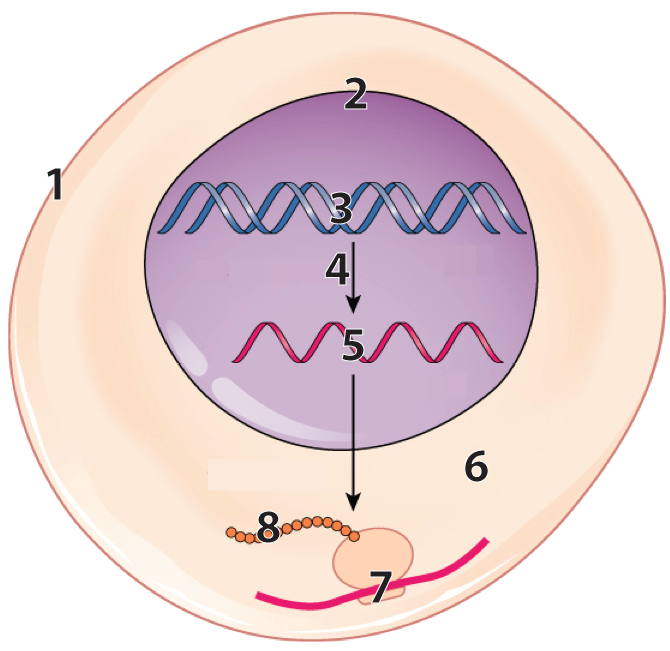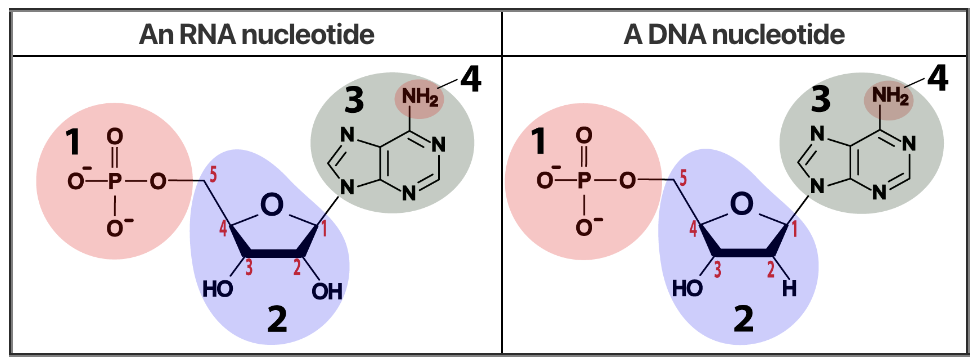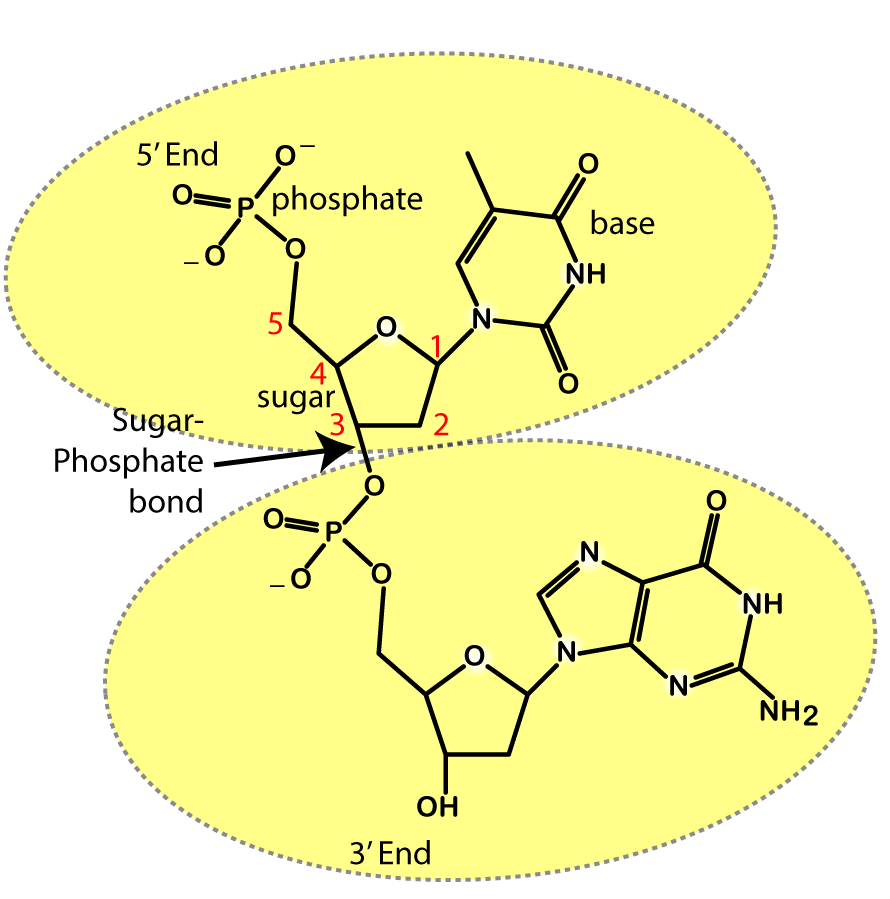1. Watch this Video
2. Study this Summary
Biological Importance of Nucleic Acids

- Nucleic Acids:
- Molecules of genetic information.
- DNA: Molecule of heredity, passed from generation to generation, and replicated during cell division.
- RNA: Functions in information transfer (e.g., messenger RNA) and can act as an enzyme (e.g., ribozymes). Serves as the molecule of heredity in certain viruses.
- ATP:
- A nucleotide monomer and the energy molecule of life.
- One of the RNA monomers.
Nucleotides are the monomers of nucleic acids

- Five-carbon sugar (2 above)
- Deoxyribose in DNA.
- Ribose in RNA.
- Phosphate group (1): Connected to the 5′ carbon of the sugar.
- Nitrogenous base (4): Connected to the 1′ carbon of the sugar.
- DNA: Adenine (A), Thymine (T), Cytosine (C), Guanine (G).
- RNA: Adenine (A), Uracil (U), Cytosine (C), Guanine (G).
Structure of DNA
- Double Helix:
- Two strands of nucleotides connected by hydrogen bonds between complementary bases:
- A always pairs with T.
- C always pairs with G.
- Strands are antiparallel:
- Oriented in opposite directions to allow hydrogen bonding.
- One strand runs 5′ to 3′; the other runs 3′ to 5′.
- Two strands of nucleotides connected by hydrogen bonds between complementary bases:
- Sugar-Phosphate Backbone:
- Nucleotides in each strand are linked by sugar-phosphate bonds.

- Nucleotides in each strand are linked by sugar-phosphate bonds.
- 5′ and 3′ Directionality:
RNA Structure and Function
![]()
- Single-Stranded: Can fold into various shapes.
- Functions:
- Information transfer (e.g., mRNA).
- Catalysis (e.g., ribozymes in ribosomes).
- Regulation (e.g., microRNAs).
3. Master these Flashcards
[qdeck qrecord_id=”sciencemusicvideosMeister1961-Nucleic Acid Flashcards” bold_text=”false”]
[h] Nucleic Acids
[i]
[start]
[q json=”true” yy=”4″ unit=”1.Chemistry_of_Life” dataset_id=”AP_Bio_Flashcards_2022|1ed774e81a910″ question_number=”38″ topic=”1.5-6.Proteins_and_Nucleic_Acids”] Describe the biological importance of nucleic acids.
[a] DNA is the molecule of heredity. It’s the informational part of the chromosomes that get passed from one generation to the next during reproduction, and from mother cell to daughter cells during growth and development.
While RNA is a hereditary molecule in some viruses, its key role is information transfer, as in messenger RNA. RNA can also act as an enzyme, catalyzing reactions: this is seen in ribosomes, spliceosomes, and microRNAs. Finally, ATP is a nucleotide monomer (a monomer of RNA). ATP is life’s key energy transfer molecule, powering most cellular work.
[q json=”true” yy=”4″ unit=”1.Chemistry_of_Life” dataset_id=”AP_Bio_Flashcards_2022|1ecd453415110″ question_number=”39″ topic=”1.5-6.Proteins_and_Nucleic_Acids”] Name the monomer of nucleic acids, and describe this monomer’s structure. Describe how these monomers are different in DNA and RNA.
[a] The monomers of nucleic acids are nucleotides, which consist of a 5-carbon sugar (at 2), a phosphate group (at 1), and one of four nitrogenous bases (at 3). The phosphate group is connected to the 5’ carbon in the sugar, and the nitrogenous base is connected to the 1’ carbon. In DNA, the sugar is deoxyribose, and the bases are adenine, thymine, cytosine, and guanine. In RNA, the sugar is ribose, and the bases are adenine, uracil, cytosine, and guanine.
[q json=”true” yy=”4″ unit=”1.Chemistry_of_Life” dataset_id=”AP_Bio_Flashcards_2022|1ec315800f910″ question_number=”40″ topic=”1.5-6.Proteins_and_Nucleic_Acids”] Explain the basis of directionality in nucleic acids, and why that’s biologically important.
[a] Nucleic acids (DNA and RNA) consist of linear chains of nucleotides. Within each nucleotide, the 5’ carbon in the nucleotide’s sugar (deoxyribose or ribose) binds with a phosphate group. That phosphate group binds with the 3’ carbon on the next nucleotide sugar in the chain.
The enzymes that build nucleotide chains are called polymerases. Their active site can only add new nucleotides to the 3’ end of a growing nucleotide strand. In other words, nucleic acids are always synthesized in a 5’ to 3’ direction. This structures the entire process of DNA replication (described in Unit 6).
[q json=”true” yy=”4″ unit=”1.Chemistry_of_Life” dataset_id=”AP_Bio_Flashcards_2022|1eb8c08b4bd10″ question_number=”41″ topic=”1.5-6.Proteins_and_Nucleic_Acids”] Describe the structure of DNA.
[a] DNA consists of two nucleotide strands. Within each strand, the nucleotides connect to one another by sugar-phosphate bonds. The strands connect to one another by hydrogen bonds between nitrogenous bases with complementary shapes: adenine bonds with thymine; cytosine binds with guanine. The binding requires that the nucleotides be oriented upside-down relative to one another. Hence, the two strands are antiparallel, with one strand running 5’ to 3’ in one direction, and the other running 5’ to 3’ in the opposite direction.
[q json=”true” dataset_id=”AP_Bio_Flashcards_2022|added1″ question_number=”42″ unit=”1.Chemistry_of_Life” topic=”1.5-6.Proteins_and_Nucleic_Acids”] How do RNA and DNA differ in their structure and function?
[a] DNA is double-stranded, forms a stable double helix, and functions as the molecule of heredity, storing genetic information. RNA is single-stranded, more versatile in shape, and functions in information transfer (e.g., mRNA), catalysis (e.g., ribozymes), and regulation (e.g., microRNAs). RNA contains uracil instead of thymine and uses ribose sugar instead of deoxyribose.
[q json=”true” dataset_id=”AP_Bio_Flashcards_2022|added4″ question_number=”45″ unit=”1.Chemistry_of_Life” topic=”1.5-6.Proteins_and_Nucleic_Acids”] What roles does RNA play in the cell?
[a] RNA plays diverse roles in the cell, including:
– Information transfer (e.g., mRNA).
– Catalysis (e.g., ribozymes in ribosomes).
– Regulation (e.g., microRNAs).
[x] [restart]
[/qdeck]
4. Tackle these Quizzes
4.1. DNA, RNA, and Nucleotides
[qwiz random = “false” qrecord_id=”sciencemusicvideosMeister1961-DNA, RNA, and Nucleotides Quiz, APBVP”]
[h] DNA, RNA, and Nucleotides
[i]
| An RNA nucleotide | A DNA nucleotide |
[q] When parents pass genes on to their offspring, they’re doing it through the transmission of [hangman].
[c]IEROQQ==[Qq]
[f]IEV4Y2VsbGVudCE=[Qq]
[q] The only place where RNA acts as the molecule of heredity is within the infectious particles known as [hangman].
[c]IHZpcnVzZXM=[Qq]
[f]IEdvb2Qh[Qq]
[q] Some RNA, like the RNA in a ribosome, acts very much like an [hangman], catalyzing the formation of chemical bonds. Other RNAs play a key role in controlling the [hangman] of DNA, which means controlling when DNA gets transcribed into RNA or translated into protein.
[c]IGVuenltZQ==[Qq]
[f]IENvcnJlY3Qh[Qq]
[c]IGV4cHJlc3Npb24=[Qq]
[f]IEV4Y2VsbGVudCE=[Qq]
[q] The monomers of nucleic acids are called [hangman].
[c]IG51Y2xlb3RpZGVz[Qq]
[f]IEdvb2Qh[Qq]
[q] The sugar in DNA is [hangman]. The sugar in RNA is [hangman].
[c]IGRlb3h5cmlib3Nl[Qq]
[f]IENvcnJlY3Qh[Qq]
[c]IHJpYm9zZQ==[Qq]
[f]IENvcnJlY3Qh[Qq]
[q] Whereas DNA has the nitrogenous base thymine, RNA uses [hangman].
[c]IHVyYWNpbA==[Qq]
[f]IEdyZWF0IQ==[Qq]
[q] The three subparts of a nucleotide are a five carbon [hangman] (at “2”), a [hangman] base (at “4”) , and a [hangman] group (at “1”).
[c]IHN1Z2Fy[Qq]
[f]IEdyZWF0IQ==[Qq]
[c]IG5pdHJvZ2Vub3Vz[Qq]
[f]IEV4Y2VsbGVudCE=[Qq]
[c]IHBob3NwaGF0ZQ==[Qq]
[f]IEdvb2Qh[Qq]
[q] DNA is the molecule of [hangman].
[c]IGhlcmVkaXR5[Qq]
[f]IEdvb2Qh[Qq]
[q] The flow of information in a cell starts with [hangman] in the cell’s nucleus. Then, the information in DNA is transformed into [hangman] which takes that information out to the cytoplasm. There, the information gets transformed into [hangman].
[c]IEROQQ==[Qq]
[f]IEV4Y2VsbGVudCE=[Qq]
[c]IFJOQQ==[Qq]
[f]IEdyZWF0IQ==[Qq]
[c]IHByb3RlaW4=[Qq]
[f]IEdvb2Qh[Qq]
[q] In the diagram below, DNA is at
[textentry single_char=”true”]
[c]ID M=[Qq]
[f]IEV4Y2VsbGVudDogJiM4MjIwOzMmIzgyMjE7IGlzIEROQS4=[Qq]
[c]ICo=[Qq]
[f]IEhlcmUmIzgyMTc7cyBhIGhpbnQ6IEROQSBpcyBhIGRvdWJsZSBoZWxpeC4=[Qq]
[c]IEVudGVyIGxldHRlcg==[Qq]
[q] In the diagram below, RNA is at
[textentry single_char=”true”]
[c]ID U=[Qq]
[f]IE5pY2U6ICYjODIyMDs1JiM4MjIxOyBpcyBSTkE=[Qq]
[c]ICo=[Qq]
[f]IEhlcmUmIzgyMTc7cyBhIGhpbnQ6IFJOQSBpcyBmb3VuZCBpbiBib3RoIHRoZSBudWNsZXVzIGFuZCB0aGUgY3l0b3BsYXNtLg==[Qq]
[c]IEVudGVyIGxldHRlcg==[Qq]
[q] In the diagram below, the polymer composed of amino acids is
[textentry single_char=”true”]
[c]ID g=[Qq]
[f]IEF3ZXNvbWU6ICYjODIyMDs4JiM4MjIxOyBpcyBwcm90ZWluLg==[Qq]
[c]ICo=[Qq]
[f]IEhlcmUmIzgyMTc7cyBhIGhpbnQ6IFByb3RlaW4gaXMgc3ludGhlc2l6ZWQgYnkgYSByaWJvc29tZS4=[Qq]
[c]IEVudGVyIGxldHRlcg==[Qq]
[q]Whereas [hangman] can only store information, [hangman] can both store information and act as a catalyst to modify other molecules.
[c]RE5B[Qq]
[c]Uk5B[Qq]
[x]
[restart]
[/qwiz]
4,2. DNA Structure Speed Quiz
[qwiz quiz_timer=”true” qrecord_id=”sciencemusicvideosMeister1961-DNA Structure Speed Quiz, APBVP”]
[h] DNA Structure Speed Quiz
[i]Note the timer in the upper right. In this quiz, you’re working toward speed and accuracy. Questions will appear below the diagrams. Go through once slowly, then increase your speed in subsequent trials.
[q hotspot_user_interaction=”label_prompt” show_hotspots=”” ] DNA structure. Click on the numbers.
Excellent! “1” is deoxyribose.
Nice! “2” represents phosphate groups
Way to go. “3” represents sugar-phosphate bonds.
Good job. “4” represents nitrogenous bases.
Nice! “5” represents a nucleotide.
Great! “6” represents hydrogen bonds.
Good work! “7” represents the sugar phosphate backbones.
[q hotspot_user_interaction=”label_prompt” show_hotspots=””] Nucleotides: click on the numbers
Nice! “1” is a phosphate group.
Yes! “2” is a nitrogenous base.
Awesome. “2” is deoxyribose.
[x][restart]
[/qwiz]
4.3. Nucleic Acids
The purpose of this tutorial was to give you an overview of nucleic acids. You’ll explore the roles of DNA and RNA in gene expression in greater detail in Unit 6 of this course. But for now, let’s consolidate everything you’ve learned by taking a quiz.
[qwiz random = “true” qrecord_id=”sciencemusicvideosMeister1961-Nucleic Acids Quiz, APBVP”]
[h]Nucleic Acids Quiz
[i] Biology Haiku
Nucleic Acids
Information molecules
Transmission of genes
[q] Both DNA and RNA are nucleotide [hangman]. The bonds that connect the nucleotides are called [hangman]-[hangman] bonds (one of which is indicated by the arrow below).
[c]IHBvbHltZXJz[Qq]
[f]IEdvb2Qh[Qq]
[c]IHN1Z2Fy[Qq]
[f]IENvcnJlY3Qh[Qq]
[c]IHBob3NwaGF0ZQ==[Qq]
[f]IEdyZWF0IQ==[Qq]
[q] In the diagram below, the structure shown at “1” is the sugar-phosphate [hangman]. Connected to each sugar are nitrogenous [hangman] (shown at “2”).
[c]IGJhY2tib25l[Qq]
[f]IEdvb2Qh[Qq]
[c]IGJhc2Vz[Qq]
[f]IEV4Y2VsbGVudCE=[Qq]
[q] In the diagram below, the number that refers to the informational part of the molecule is
[textentry single_char=”true”]
[c]ID I=[Qq]
[f]IEV4Y2VsbGVudC4gSW4gbnVjbGVpYyBhY2lkcywgaW5mb3JtYXRpb24gaXMgc3RvcmVkIGluIHRoZSBzZXF1ZW5jZSBvZiB0aGUgbml0cm9nZW5vdXMgYmFzZXMsIHdoaWNoIGFyZSBzaG93biBhdCAmIzgyMjA7Mi4mIzgyMjE7[Qq]
[c]IEVudGVyIHdvcmQ=[Qq]
[f]IE5vLCB0aGF0JiM4MjE3O3Mgbm90IGNvcnJlY3Qu[Qq]
[c]ICo=[Qq]
[f]IE5vLiBJbmZvcm1hdGlvbiBpcyBzdG9yZWQgaW4gdGhlIHNlcXVlbmNlIG9mIG5pdHJvZ2Vub3VzIGJhc2VzLiBXaGljaCBudW1iZXIgcmVmZXJzIHRvIHRoYXQgcGFydD8=[Qq]
[q] The bonds between adenine and thymine below are[hangman] bonds.
[c]IGh5ZHJvZ2Vu[Qq]
[f]IENvcnJlY3Qh[Qq]
[q] The accuracy of DNA replication is based on the fact that adenine can only bond with [hangman], and cytosine can only bond with [hangman].
[c]IHRoeW1pbmU=[Qq]
[f]IENvcnJlY3Qh[Qq]
[c]IGd1YW5pbmU=[Qq]
[f]IEV4Y2VsbGVudCE=[Qq]
[q] In DNA’s double-stranded structure, the bases have to be oriented upside-down relative to one another to form hydrogen bonds. The name for the orientation of each strand relative to the other one is [hangman].
[c]IGFudGlwYXJhbGxlbA==[Qq]
[f]IEV4Y2VsbGVudCE=[Qq]
[q] In DNA, information is stored in the [hangman] of the nitrogenous bases.
[c]IHNlcXVlbmNl[Qq]
[f]IEdyZWF0IQ==[Qq]
[q] Whereas DNA uses the nitrogenous base thymine (along with adenine, cytosine, and guanine), RNA uses [hangman].
[c]IHVyYWNpbA==[Qq]
[f]IENvcnJlY3Qh[Qq]
[q]In molecules like the tRNA shown below, the three-dimensional shape of the molecule is stabilized by [hangman] bonds that form between [hangman] nitrogenous bases (such as adenine and uracil).
[c]aHlkcm9nZW4=[Qq]
[c]Y29tcGxlbWVudGFyeQ==[Qq]
[q]In the diagram below, genetic information in the form of [hangman] (at “3”) gets transcribed into [hangman] (at “5”), which then goes to the cytoplasm where it’s translated by a ribosome into [hangman] (at “8”).
[c]RE5B[Qq]
[c]Uk5B[Qq]
[c]cHJvdGVpbg==[Qq]
[q]Whereas DNA is almost always [hangman] stranded, RNA is [hangman] stranded.
[c]ZG91Ymxl[Qq]
[c]c2luZ2xl[Qq]
[x][restart]
[/qwiz]
What’s next?
This topic ends Unit 1 of the AP Bio Video Pathway
- To choose another topic in our AP Bio Video Pathway, go to the AP Bio Video Pathway Main Menu
- To review Unit 1, the Molecules of Life, go to the Unit 1 Review Page: Objectives, Flashcards, and Quizzes
- To prepare for the AP Bio exam, go to our AP Bio Review Menu to access comprehensive flashcards, MCQs, and FRQs.

